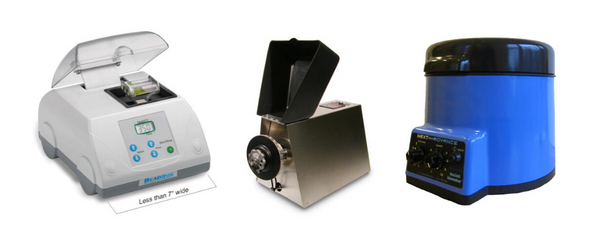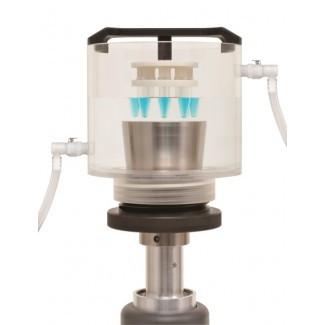There are certain applications for which both a bead mill homogenizer and an ultrasonic homogenizer may be appropriate. However, in most cases, one technology is preferable over the other. The trick is determining which one is most suitable for your application.
In this article, we discuss the pros and cons of bead mill homogenizers and ultrasonic homogenizers. We will also provide handy summaries of the different features of each technology and which applications they are most suitable for.
Bead Mill Homogenizers
A bead mill homogenizer process involves placing your samples in tubes along with beads. The tubes are then vigorously shaken, producing collisions between the particles, beads, and walls of the tube. It is these collisions that result in your sample being homogenized.

Left to right: A BeadBug™, a Mini-Beadbeater, and a Bullet Blender®.
Pros of Bead Mill Homogenizers
- They can be used for processing multiple samples simultaneously, making them suitable for high-throughput applications.
- You can use them for solid or liquid samples.
- The risk of cross-contamination is virtually eliminated since disposable tubes are used.
- The risk of aerosolization is also minimized since the tubes are closed.
- They are suitable for a range of applications and there are different types of beads available for various uses.
- Some bead mill homogenizers are designed for use with hazardous or infectious material, further broadening their application potential.
Cons of Bead Mill Homogenizers
- In a laboratory setting, this type of homogenization is limited in terms of sample size. A single tube will hold only a few grams or milliliters of sample for processing.
- Due to the nature of the process, trace amounts of the bead material could end up in your sample. This may be a concern for certain applications.
- They can be loud.
- Some use proprietary tubes, which along with the beads can lead to a non-trivial cost to process samples in higher-throughput applications.
Ultrasonic Homogenizers
An ultrasonic homogenizer (also known as a “sonicator”) has a vibrating probe (horn) that is inserted into the sample. The vibrations are extremely rapid, causing particles around the probe to be blasted with huge amounts of energy. Bubbles form and collapse in the solution in a process called cavitation, which creates shear and shock waves.

Left to right: A Q500 Sonicator and a Sonifier® SFX150.
Pros of Ultrasonic Homogenizers
- They are very powerful and can impart a large amount of energy over a small area.
- You can use them to achieve small particle sizes in a relatively short period of time.
- They are easy to clean as the probes are comprised of a single piece.
- You can switch between probes for a given unit and process a decent range of sample sizes.
- They are fast at processing single, liquid samples.
Cons of Ultrasonic Homogenizers
- They can generate a large amount of heat so may not be suitable for heat-sensitive applications.
- The process may result in trace amounts of titanium ending up in the sample, which may be a concern for certain applications.
- These are rarely used for plant-scale applications, so can be limiting where future scale-up may be required.
- Horns may need frequent replacement with heavy use.
- They can create a lot of noise, so the choice of location is important.
- They’re not suitable for solid samples or high-viscosity liquids.
Summary of Bead Mill Homogenizers Versus Ultrasonic Homogenizers
In general, ultrasonic homogenizers are more suitable for low-throughput applications involving liquid samples. They are more suitable than a bead mill homogenizer for larger volumes, and can be scaled up to some extent, although the technology doesn’t scale as well as others, and they are infrequently used in industrial-scale homogenization applications..
If you need to process multiple samples in succession, it may be rather time-consuming to have to clean the probe between each run. This is especially the case if you’re concerned about contamination and need to perform a thorough cleaning each time. There are some cup horns available which permit ultrasonic energy to be applied to multiple samples without direct contact with the horn. These are useful in preventing cross-contamination but they are only suitable for smaller volume applications which do not require high-intensity processing.

Cup Horn for the Q500 & Q700 Sonicators.
There are also ultrasonic homogenizers capable of high-throughput, for example, the DPS-20 Homogenizing System, but these tend to be pricey.
If high-throughput is a priority and you’re working with small sample sizes, then a bead mill homogenizer is more suitable. If you’re working with temperature-sensitive materials, this is another scenario where you’re better off with a bead mill homogenizer as an ultrasonic homogenizer tends to generate more heat.
The following table summarizes some of the main features of both technologies:
|
Bead Mill Homogenizer |
Ultrasonic Homogenizer |
|
|
Particle Size |
Min particle size: ~500 nm |
Min particle size: <100 nm |
|
Sample Size |
1 μL – 200 mL |
10 μL – 20 L |
|
Max. Viscosity |
~ 100 cP |
~ 4,000 cP |
|
Throughput |
Generally high |
Generally low |
|
Scaleup |
Not very suitable for scaleup |
Suitable for some scaleup |
|
Heat Generated |
Very little to some heat generated |
A lot of heat generated |
|
Ease of Use |
Simple to set up and ideal for multiple samples |
Easy to set up and good for single samples |
|
Cleaning |
Usually uses single-use tubes so little or no cleaning is required |
Fairly simple to clean between uses – only the probe requires surface cleaning |
The suitability of one homogenizer technology over another is dependent on the nature of your application. Below are some common applications for bead mill homogenization and ultrasonic homogenization:
|
Rotor-Stator Homogenizer |
Bead Mill Homogenizer |
|
Tissue homogenization Cell lysis Milling / Grinding Tissue disruption / Cell isolation Organelle extraction Particle size reduction (small samples only) |
Nanoparticle creation Emulsification Particle size reduction Cell lysis Tissue homogenization |
